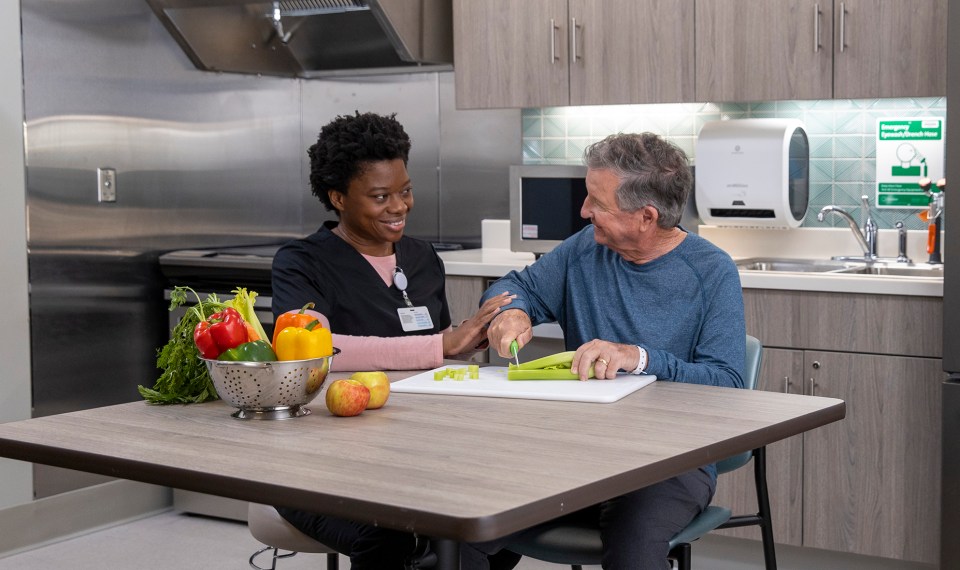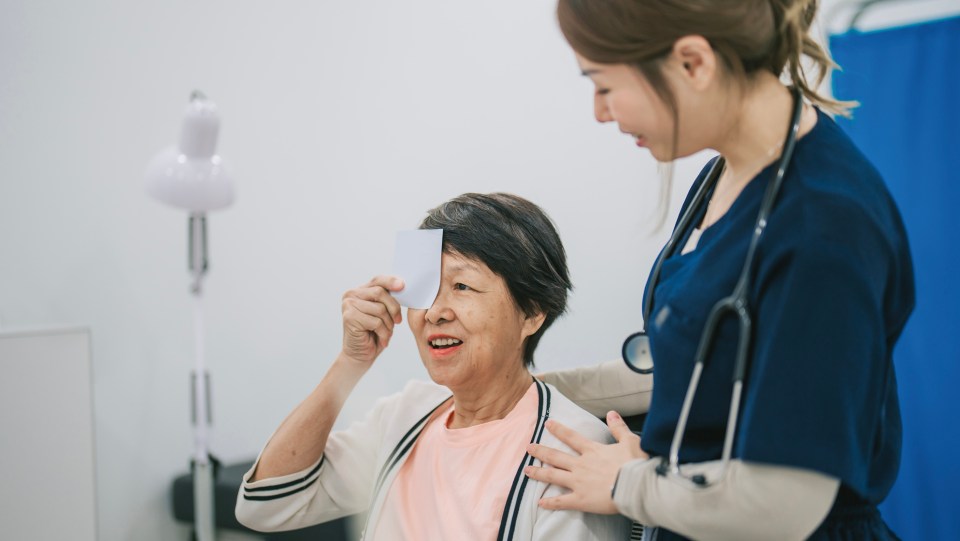Tim was admitted to Encompass Health Rehabilitation Hospital of Cincinnati at Norwood after surviving a stroke. He had right sided weakness in his arm and leg, and his speech was slurred. Tim was eager to start his rehabilitation and regain his independence. During his occupational therapy evaluation, Tim stated that his goal was to return to walking and return home to his family and children. Upon further questioning and gaining insight into his life, Tim was eager to be able to dress himself, use the toilet without assistance, feed himself and return to his work as a chef. His occupational therapy for stroke started the day after arrival at Encompass Health.
How Does a Stroke Impact an Individual?
A stroke occurs when a blood vessel that carries oxygen and nutrients to the brain is either blocked by a clot or bursts. This causes blood to flow into the brain, blocking part of it from getting the blood and oxygen it needs. When this happens, brain cells die, and the body does not work as it did prior to the stroke. There can be changes in physical abilities, cognitive capacities, communication difficulties and emotional changes after a stroke. The American Stroke Association, a division of the American Heart Association, recommends an inpatient rehabilitation hospital, like Encompass Health, for the best possible outcomes. All Encompass Health inpatient rehabilitation hospitals have a multidisciplinary team approach in order to address the complex nature of stroke rehabilitation.
A common list of stroke risk factors which an individual can control or manage with routine doctor appointments to decrease the risk of stroke include:
- Diabetes
- High blood pressure
- Smoking
- Diet
- Physical inactivity
- Obesity
- Carotid Artery Disease
- Atrial Fibrillation
- Sickle Cell Disease
A common list of stroke risk factors which an individual cannot control but can be aware of their increased risk for stroke include:
- Age
- Family History
- Race
- Gender
- Prior stroke, TIA or heart attack
The acronym BE FAST was created to help identify when a stroke is occurring and what to do.
B – Balance – Has an individual’s balance changed suddenly?
E – Eyes – Does an individual have double or blurred vision?
F – Face – Does one side of the face droop?
A – Arm – Does one arm or leg not move like the opposite side? Is there weakness or decreased ability to grasp?
S – Speech – Does an individual have difficulty saying what they want to or do the words not make sense?
T – Time – If any of these symptoms are occurring, it is time to call 911 for immediate attention. It is important to seek immediate medical care for a suspected stroke.
How Can Occupational Therapy for Stroke Help in Recovery?
Occupational therapists address barriers related to everyday tasks and activities that someone might have after a stroke. This can include regaining independence in basic self-care tasks such as eating, grooming, toileting, dressing and bathing as well as money management, cleaning, cooking and medication management. Occupational therapists specialize in remediation and adaptive techniques to increase an individual’s ability to complete tasks without assistance. Through individualized treatment plans, a patient will have one-on-one therapy sessions, group interventions and innovative rehabilitation technology to increase their ability to function independently. Home modification evaluation and strategies, cognitive coping strategies and community reintegration training are all within an occupational therapist’s area of expertise.
Occupational therapists are part of a multidisciplinary team that focuses on returning a patient to their highest level of function. Additional members of the team could include physicians specializing in rehabilitation, physical therapists, speech therapists, rehabilitation nurses, dieticians, pharmacists and case managers. All members of the team are an integral part of increasing a patient’s ability to return to their independent living.
Tim’s Story, Continued
Tim worked with occupational, physical and speech therapists during his 14-day stay at Encompass Health. His occupational therapist created an individualized therapy program focusing on improving his ability to use his right arm to assist him in his daily living tasks. Through traditional rehabilitation and the use of innovative rehabilitation technology like the Bioness H200 and the Saebo Rejoyce, he was able to return to cooking and met his goals of being able to walk to the bathroom to use the bathroom and shower by himself and dress himself. Tim was very thankful that his occupational therapist looked deeper into his goals and his valued occupations to return to the life he loved prior to his stroke.
*Name of individual changed
References:
Stroke Communications Kit | cdc.gov
Stroke-Rehab-fact-sheet.pdf (aota.org)
About Stroke | American Stroke Association
Healthcare Provider Rehabilitation Resources | American Stroke Association
Stroke Risk Factors | American Stroke Association
The content of this site is for informational purposes only and should not be taken as professional medical advice. Always seek the advice of your physician or other qualified healthcare provider with any questions you may have regarding any medical conditions or treatments.




